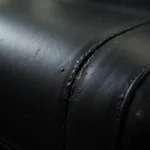A tear in your leather car seat can be a real eyesore, diminishing the overall aesthetic and value of your vehicle’s interior. While it might seem daunting, repairing a leather car seat tear yourself can be a cost-effective solution. This comprehensive guide will walk you through the steps, materials, and expert tips to help you achieve professional-looking results.
Assessing the Damage: Knowing Your Repair Options
Before diving into the repair process, it’s crucial to assess the severity of the tear. This will determine the best course of action and the materials you’ll need:
- Small Tears and Cracks: These can often be addressed with a leather filler or adhesive, followed by color matching and sealing.
- Medium Tears with Loose Edges: These might require a combination of patching, filling, and dyeing to achieve a seamless repair.
- Large Tears and Rips: For extensive damage, consulting a professional upholstery shop is recommended, as they have the expertise and specialized tools for complex repairs.
Gathering Your Repair Arsenal: Essential Tools and Materials
To effectively repair a leather car seat tear, you’ll need the right tools and materials:
Tools:
- Cleaning Supplies: Leather cleaner, microfiber cloths, rubbing alcohol
- Scissors
- Tweezers
- Palette Knife or Spreader
- Heat Gun or Hair Dryer (optional)
- Sandpaper (fine-grit)
Materials:
- Leather Repair Kit (color-matched to your seat)
- Leather Filler or Adhesive
- Leather Dye (if necessary)
- Leather Sealer
- Backing Fabric (for larger tears)
Step-by-Step Guide: Repairing Your Leather Car Seat Tear
1. Clean the Affected Area: Start by thoroughly cleaning the torn area and surrounding leather with a dedicated leather cleaner. This removes dirt, grime, and oils that can hinder adhesion. Allow the area to dry completely.
2. Prepare the Tear: For tears with loose edges, carefully trim any frayed threads or uneven surfaces with small scissors. Be sure to avoid cutting into the healthy leather.
3. Apply Leather Filler: Using a palette knife or spreader, carefully apply the leather filler to the tear, ensuring it fills the gap evenly. For deeper tears, you may need to apply multiple thin layers, allowing each layer to dry completely before applying the next.
4. Smooth and Blend: Once the filler is dry, use fine-grit sandpaper to gently sand the area until it’s smooth and flush with the surrounding leather. This ensures a seamless finish.
5. Apply Leather Dye (if needed): If the tear has exposed a different color underneath or if the filler doesn’t perfectly match your seat color, apply a color-matched leather dye according to the manufacturer’s instructions. Allow the dye to dry completely.
6. Apply Leather Sealer: To protect your repair and restore the leather’s natural shine, apply a high-quality leather sealer to the entire seat. This also helps to prevent future cracking and fading.
Expert Tips for a Flawless Repair
- Test on a Hidden Area: Before applying any product to the visible tear, always test it on a hidden area of your car seat to ensure color compatibility and prevent unwanted reactions.
- Work in Thin Layers: When applying filler or dye, work in thin layers to prevent clumping and ensure even coverage.
- Use Heat Sparingly: If using a heat gun or hair dryer to speed up drying time, do so with caution and low heat to avoid damaging the leather.
- Maintain Regularly: To keep your leather car seats in top condition and prevent future tears, regular cleaning, conditioning, and protection are crucial.
Conclusion: Restoring Your Car’s Interior With Confidence
Repairing a leather car seat tear might seem intimidating at first, but with the right approach and a little patience, you can achieve impressive results. By following this guide and utilizing the expert tips provided, you can restore your car’s interior to its former glory and prolong the lifespan of your leather seats.
Remember, if you’re dealing with extensive damage or are unsure about any step of the process, consulting a professional upholstery shop is always a wise decision.


